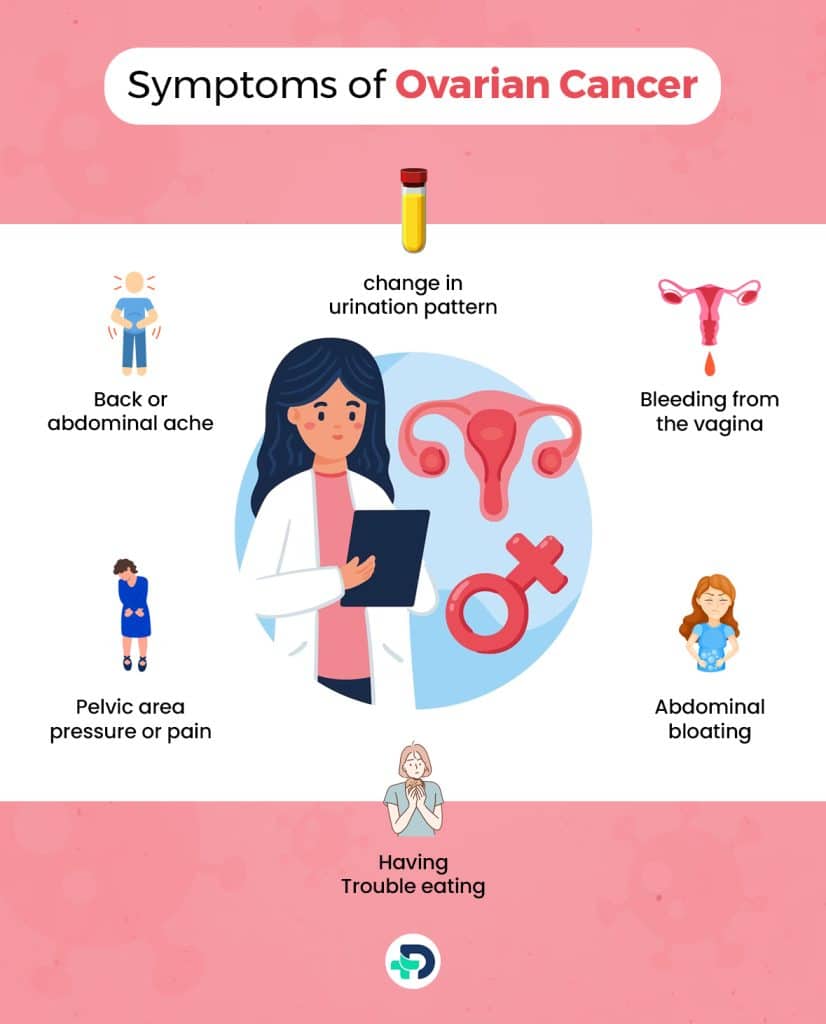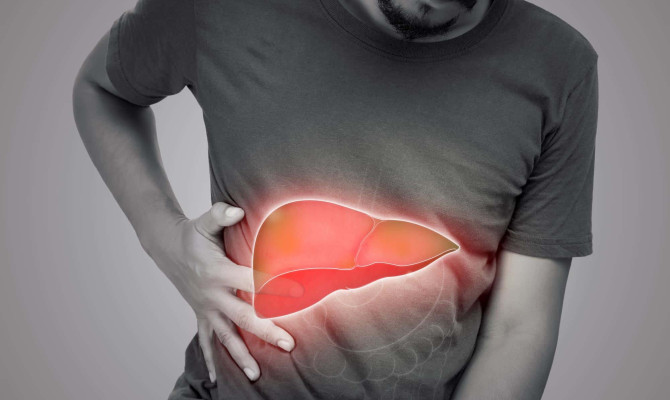Ovarian Cancer: What Do You Need to Know?

- Ovarian Cancer
- 22 Aug 2023
Overview
About Ovarian Cancer
Cancer is a medical condition in which the body’s aberrant cells uncontrolled multiply. Cancer is usually termed as the area of the body where it first develops even if it later spreads to other body areas1Overview| Researched based study from Cdc.gov A category of illnesses known as ovarian cancer starts in the ovaries or nearby organs like the peritoneum and fallopian tubes.
Ovarian cancer is the 7th most common cause of mortality in women.4Overview| Researched based study from Nlm.nih.gov One ovary is situated on either side of the uterus in women. On both sides of the uterus, fallopian tubes are present which are a pair of long and slender tubes. The fallopian tubes help to carry eggs from the ovaries to the uterus. The tissue lining that protects the abdominal organs is called the peritoneum.
To determine if the symptoms present are because of some other reason other than cancer is by consulting the physician, other healthcare provider or nurse.

Types
Types of Ovarian Cancer
The majority of ovarian epithelial tumors are benign. However, the most prevalent kind of ovarian cancer is malignant epithelial tumors, sometimes referred to as epithelial ovarian carcinomas. The epithelial cells that line the ovary’s outer surface are thought to be the source of between 85 and 90 % of ovarian malignancies, according to the American Cancer Society. Prior to spreading to other bodily regions including the lungs and liver, they frequently affect the lining and organs of the abdomen and pelvis first. The bones, brain, and skin might also be affected.
Serous Carcinomas
- These account for 52 % of all epithelial ovarian malignancies and are frequently categorized as high-grade or low-grade carcinomas based on how the cancer cells differ from normal cells in appearance2Types| Researched based study from Nlm.nih.gov A higher grade indicates that the cancer cells are dividing quickly and may benefit most from chemotherapy.
Clear Cell Carcinoma
- When detected and treated in its early stages, clear cell carcinomas, a rare form of ovarian cancer, have a favorable prognosis.
Endometrioid Carcinomas
- These grow gradually and rarely manifest any symptoms. These tumors do not usually react to treatments as well, despite the fact that they might not spread as quickly to other parts of the body.
Mucinous Carcinomas
- These typically affect older women. Rarely are these slow-growing tumors detected in women under 352Types| Researched based study from Nlm.nih.gov
Causes
Causes of Ovarian Cancer
Ovarian cancer is accompanied by a number of risk factors:
- It primarily affects postmenopausal women. Also as women get older, the stage, incidence, and reported survival rates of the disease increase.
- A few studies have shown that parity has a protective role. Also older childbearing ages are associated with a decreased incidence of ovarian cancer.2Causes| Researched based study from Nlm.nih.gov
- A history of breast cancer increases the chances of ovarian cancer whereas a family history of ovarian cancer also increases it.
- Various studies have revealed that smoking increases the risk, especially the risk of developing mucinous epithelial cancers2Causes| Researched based study from Nlm.nih.gov
Risk Factors
Risk Factors of Ovarian Cancer
We cannot predict with certainty if one will develop ovarian cancer. The majority of women acquire it without being at high risk. However, a number of things can raise a woman’s risk for ovarian cancer, that includes:
- Middle-aged women.
- Close relatives with ovarian cancer on either the mother’s side or the father’s side, such as the mother, aunt, sister, or grandmother.
- If women possess a risk-raising genetic mutation, such as a BRCA1 or BRCA2 mutation or one linked to Lynch syndrome.
- A woman has a history of breast, colorectal, or uterine cancer.
- A woman has endometriosis. It is a disorder in which tissue from the uterine lining develops in different parts of the body.
- A woman who never had children or experienced difficulties becoming pregnant.
- Women who use estrogen alone for 10 years or longer may be at an increased risk of developing ovarian cancer1Risk factors| Researched based study from Cdc.gov
Symptoms

Symptoms of Ovarian Cancer
Here are the signs and symptoms that could be brought on by ovarian cancer:
- Bleeding from the vagina or vaginal discharge, especially after menopause
- Pelvic area pressure or pain
- Back or abdominal ache
- Abdominal bloating
- Having trouble eating, or feeling full too quickly
- A change in urination pattern, such as an increased need to urinate quickly or frequently or constipation.
Consult a doctor immediately if one experiences unexpected vaginal bleeding. Consult a doctor if any additional symptoms persist for two weeks or longer and are not typical1Symptoms| Researched based study from Cdc.gov
Stages
Stages of Ovarian Cancer
To know the course of the malignancy, clinicians first consider the following criteria:
- When the cancer has not spread from the ovaries, it is localized.
- When the cancer has spread to the different tissues or lymph nodes, the disease is regional.
- When the cancer has progressed to other bodily areas, be distant.
The stages are as follows:
Stage 1 Ovarian Cancer
- Stage 1 cancer is limited to the ovaries. It has not yet metastasized to the pelvis, abdomen, or lymph nodes, nor has it traveled to other locations2Stages| Researched based study from Nlm.nih.gov
- Since it is cancer in its early stages, the chances of survival are extremely high. A patient’s tumor is normally given a tumor grade if it is present and can be removed by a biopsy or surgery. Grades from levels 1 through 3 might be low or high. If a patient has a low-grade tumor, extra treatment may not be necessary after surgery for stage 1 ovarian cancer.
- However, chemotherapy may be advised in addition to additional surgery if a patient is found to have stage 1B or 1C cancer.
Stage 2 Ovarian Cancer
- Stage 2 cancer refers to the spread of the disease from either one or both the ovaries to other pelvic regions.
- However, neither neighboring lymph nodes have been affected by the malignancy.
- For staging and debulking, a patient may have chemotherapy as well as surgery, such as a hysterectomy or bilateral salpingo-oophorectomy.
Stage 3 Ovarian Cancer
- In stage 3, the cancer has not yet progressed to distant regions but has expanded to surrounding lymph nodes and other areas of the abdomen.
- Stage 3 treatment is frequently identical to stage 2 treatment, however, stage 3 cancer patients may need additional chemotherapy and closer follow-up care.
Stage 4 Ovarian Cancer
- Stage 4 cancer indicates that the cancer has spread beyond the abdomen.2Stages| Researched based study from Nlm.nih.gov
- This ovarian cancer is classified as metastatic, which indicates that it has spread beyond the original site of the tumor.
- Stage 4 ovarian cancer treatment is based on the needs of the patient.
- Chemotherapy or surgery could be the first step. The management of primary peritoneal and fallopian tube malignancies is similar to that of ovarian cancer.
Diagnosis
Diagnosis of Ovarian Cancer
Women without any symptoms or indicators of ovarian cancer cannot be trustfully screened for this disease. When a test is done to check for a disease before any symptoms appear, this is referred to as screening.
- When cancer is detected early, when therapy is most effective, cancer screening tests are effective. When a person exhibits symptoms, diagnostic tests are conducted.
- Finding the cause of the symptoms, or making a diagnosis, is what diagnostic tests are used for. In order to check someone who is thought to have a high risk of developing cancer, diagnostic tests may also be employed.
- Transvaginal ultrasonography is a very sensitive test.
- Abdominal and pelvic ultrasonography are usually performed on patients who have a high level of clinical suspicion of ovarian cancer.
- It provides an overall idea of the complexity, location, and size of the ovarian mass.
- Few imaging techniques, such as PET scan, pelvic MRI, chest or abdominal pelvis CT scan, can be helpful to determine tumor extension2Diagnosis| Researched based study from Nlm.nih.gov
Differential Diagnosis:
The differential diagnosis of ovarian cancer is as follows:
- Peritoneal cyst
- Retroperitoneal mass
- Colon cancer
- Embryological remnants
- Serous adenocarcinomas
- Undifferentiated adenocarcinomas
- Uterine fibroids
- Endometriosis
- Gastric adenocarcinoma
- Metastatic gastrointestinal carcinoma
- Small-cell adenocarcinomas
- Brenner tumors
- Ovarian torsion2Diagnosis| Researched based study from Nlm.nih.gov
Treatment
Treatment of Ovarian Cancer
The treatment for the condition can depend on a number of factors such as the stage of the cancer, types, any potential adverse effects, the woman’s age, and if she plans to have children. Surgical removal of the uterus, adjacent lymph nodes, fallopian tubes, ovaries, appendix, omentum, and other nearby organs and tissues is typically the first line of treatment recommended for ovarian cancer. For epithelial ovarian cancers, chemotherapy is often suggested after surgery.
Reliable treatments available for ovarian cancer are as follows:
Surgery
- Surgery depends upon the stages and location of the cancer, a variety of surgical techniques can be performed.
- Salpingo-oophorectomy, or the unilateral or bilateral removal of one or both ovaries and fallopian tubes.
- Hysterectomy, It is a treatment that involves the removal of the cervix and the uterus.
- Removal of the lymph node or debulking.
- Removal of the appendix or other intestinal organs.
- Individualized treatment plans are available for people with recurrent ovarian cancer and may consist of surgery followed by chemotherapy or only chemotherapy2Treatment| Researched based study from Nlm.nih.gov
Targeted Therapy
- It is used to treat ovarian cancer as PARP inhibitors.3Treatment| Researched based study from Cancer.gov
- PARP inhibitors are made to prevent the poly ADP-ribose polymerase (PARP) enzyme from detecting damaged DNA inside cancer cells.
- This could prevent cancer cells from self-repairing.
- Some PARP inhibitor medications have received approval from the U.S. Food and Drug Administration to treat ovarian cancer.
Chemotherapy
- Chemotherapy medications are used to either eradicate cancer cells or stop their growth. This therapy can be used to treat cancer cells that are left after the tumor has been removed or to decrease huge tumors to facilitate surgery.
- Hyperthermic intraperitoneal chemotherapy (HIPEC) is given orally, intravenously, or intraperitoneally using a catheter.
Hormone Therapy
- The goal of hormone therapy is to deprive ovarian tumor cells of the hormones, such as estrogen, that are necessary for their growth.
- After chemotherapy and other treatments for ovarian cancer, hormone therapy may be carried out.
- Patients receiving hormone therapy for ovarian cancer frequently use a family of medications that reduce estrogen levels in the body.
- Few ovarian stromal tumors are more typically treated with this method.
Radiation Therapy
- The main aim of radiation therapy is to either destroy or inhibit the growth of cancer cells.
- When a patient’s other treatment choices are limited for ovarian cancer, radiation therapy may be suggested if the tumor is localized to a specific location and can be treated with the radiation beam.
Fertility Preservation
- Prior to receiving cancer treatment, ovarian tissue is frozen in the interest of preserving ovarian eggs or allowing women to have children in the future.
- Young women with cancer frequently worry about preserving their fertility, especially if they have cancer of the reproductive system.
- The cervix, fallopian tubes, uterus, or ovaries may need to be removed in some circumstances for a tumor to be surgically removed.
- Treatments like radiation therapy or chemotherapy can harm these organs even without surgery.
- Before starting any therapy, consult the doctor3Treatment| Researched based study from Cancer.gov
Prevention
Prevention of Ovarian Cancer
Some mutations can make it more likely to develop ovarian cancer. The most frequent mutations that increase the risk of ovarian cancer include those linked to Lynch syndrome and those in the BRCA1 and BRCA2 breast cancer susceptibility genes1Prevention| Researched based study from Cdc.gov There is no proven strategy for preventing ovarian cancer. These factors are linked to a lower risk of developing it.
Removing the Fallopian Tubes
- Removing the fallopian tubes and postponing removal of the ovaries would have the same impact on lowering the risk of ovarian cancer with BRCA1 mutations in women along with removal of the ovaries and fallopian tubes. Hence many menopausal problems would be postponed and women could manage their premenopausal levels of hormones produced by the ovaries3Prevention| Researched based study from Cancer.gov
Checking for Gene Mutations in Family Members
- The NCI is financing initiatives to screen the family members of women who have previously been diagnosed with ovarian cancer. In order to identify women who have already been diagnosed with ovarian cancer and test their family members for ovarian cancer-related gene mutations there has been research going on3Prevention| Researched based study from Cancer.gov
- If a mutation is found, then the family members can then take precautions to lessen their risk. The main aim is to determine the most effective means of informing ovarian cancer patients and their families with sensitive genetic information while also preventing ovarian cancer.
Removing the Fallopian Tubes
- Removal of fallopian tubes in women who want to avoid getting pregnant. The realization that the fallopian tubes are where epithelial ovarian malignancies most frequently develop has also caused some gynecologists to alter their surgical methods for preventing conception. Women who want to have their tubes tied or tubal ligated to avoid pregnancy may be given the choice to have their tubes removed instead. By doing this, the risk of developing ovarian cancer in the future may be decreased3Prevention| Researched based study from Cancer.gov
Other preventive measures are:
- Use birth control tablets for at least five years.
- Women who have breastfeed for the past 1 year or even more than that may experience a somewhat lower incidence of ovarian cancer3Prevention| Researched based study from Cancer.gov
Complications
Complications of Ovarian Cancer
In the last six months of ovarian cancer victims were found to experience a variety of problems, the most frequent of which were:
- Weakness or exhaustion (75 %).
- Vomiting or nausea (71 %)
- Indigestion (49 %)
- Foot edema (44 %)
- Anemia (34 %) [2]
- Along with nutritional issues, it is usually discovered that women who were not eligible for therapy have major problems like intestinal obstruction, bladder obstruction, pleural effusion, and ascites2Complications| Researched based study from Nlm.nih.gov
Bottom Line
The Bottom Line
Treatment is most beneficial when ovarian cancer is found in its early stages. It is extremely important to pay attention to our body and make sure to understand their typical signs and symptoms because ovarian cancer frequently manifests its signs and symptoms. Sometimes making the correct treatment choice can be difficult. But discussing the treatment options and strategies with the oncologist based on the type and stage of the cancer can be helpful. The advantages, risks, and potential side effects of each treatment should be discussed with the doctor and then proceeded.1Bottom line| Researched based study from Cdc.gov
Any feedback on this article?
 This Articles content was accurate
This Articles content was accurate Very Informative Article
Very Informative Article I have a question or a comment
I have a question or a comment
 This article contains inaccurate content
This article contains inaccurate content This article was not helpful
This article was not helpful I have a question or a comment
I have a question or a comment
We appreciate your helpful feedback!
Checkout our social pages
References
-
Centers for Disease Control and Prevention
Basic Information About Ovarian Cancer | Overview | Symptoms | Risk Factors |
-
National Library of Medicine
Ovarian Cancer | | Causes | Complications | Stages | Types | Differential Diagnosis
-
National Cancer Institute
Advances in Ovarian Cancer Research | Treatment | Prevention
-
National Library of Medicine
Epidemiology of ovarian cancer: a review | Overview






































